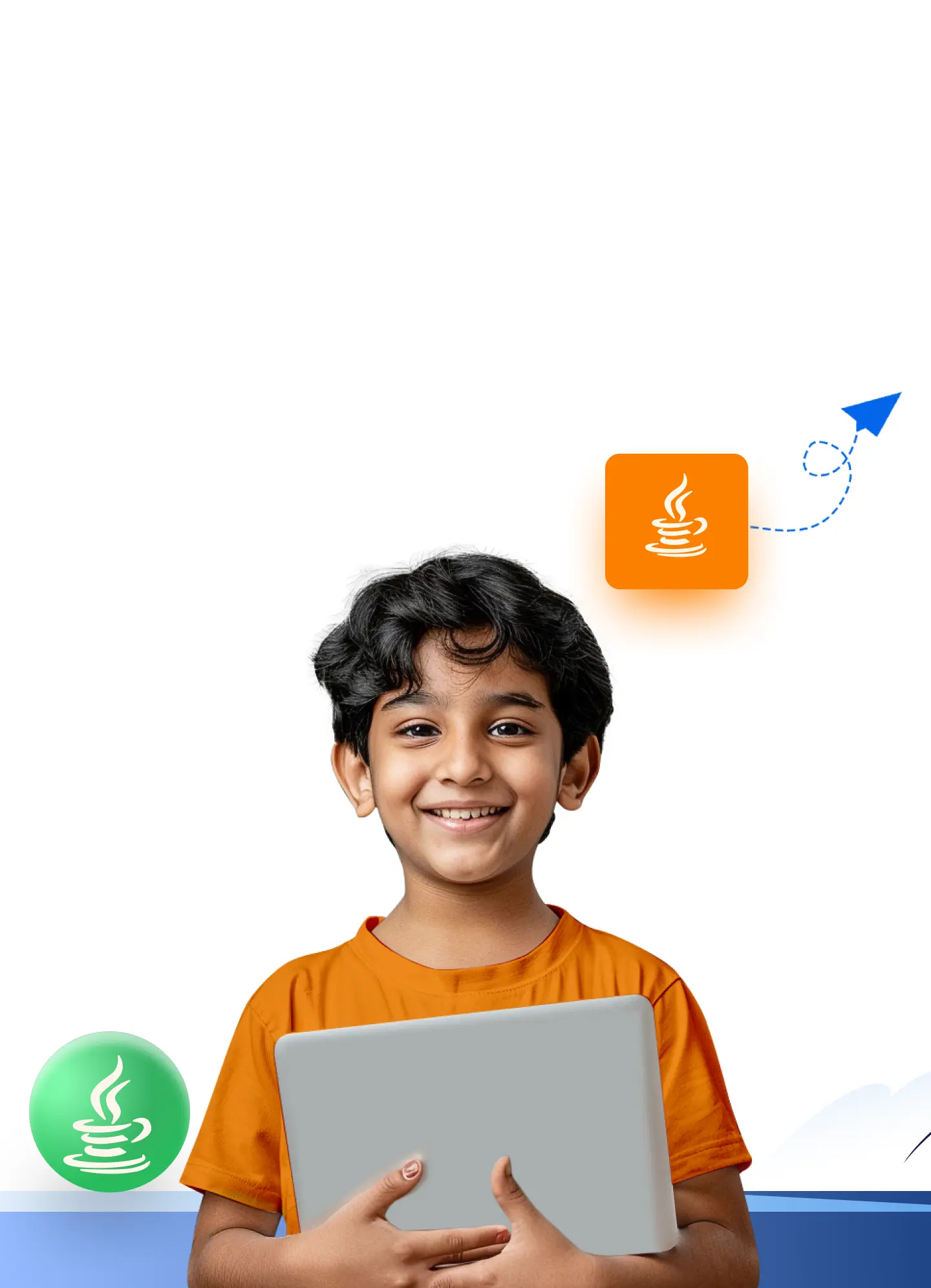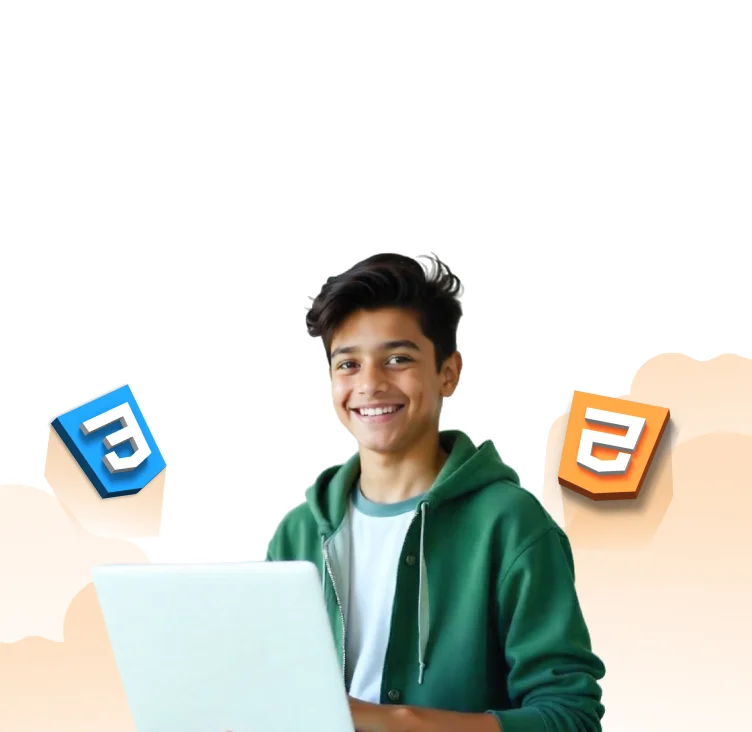Fun and Easy Python Projects for Kids of All Ages
By SaanchiHave you ever thought about what makes most games and apps work? It’s all thanks to the programming language called Python!
Learning Python is like getting hold of a magic wand that unlocks a new world of possibilities. Kids can create their own games and puzzles and even tell stories with animations. Through Python projects, they sharpen their minds, thinking in new ways and solving problems like detectives.
Whether they’re just starting or already a mini-coding expert, there’s always something new to discover and create with Python. Let’s understand more about the benefits of learning Python and some of the most fun and easy Python projects for kids to begin their learning journey.
Why Python Projects Are Great for Kids
By working on Python projects, kids can see their ideas come to life right before their eyes! This hands-on experience is not just super exciting but also super educational. It teaches kids how to think like real programmers and solve problems creatively.
Plus, these Python kid projects give a peek into how the apps and games they love are built, making learning super relevant and fun.
7 Unique Project Ideas for Kids to Practice Python
The following Python project ideas will turn your kids into Python pros! Let’s explore them one by one:
1) The Turtle Game (from HackerKID)
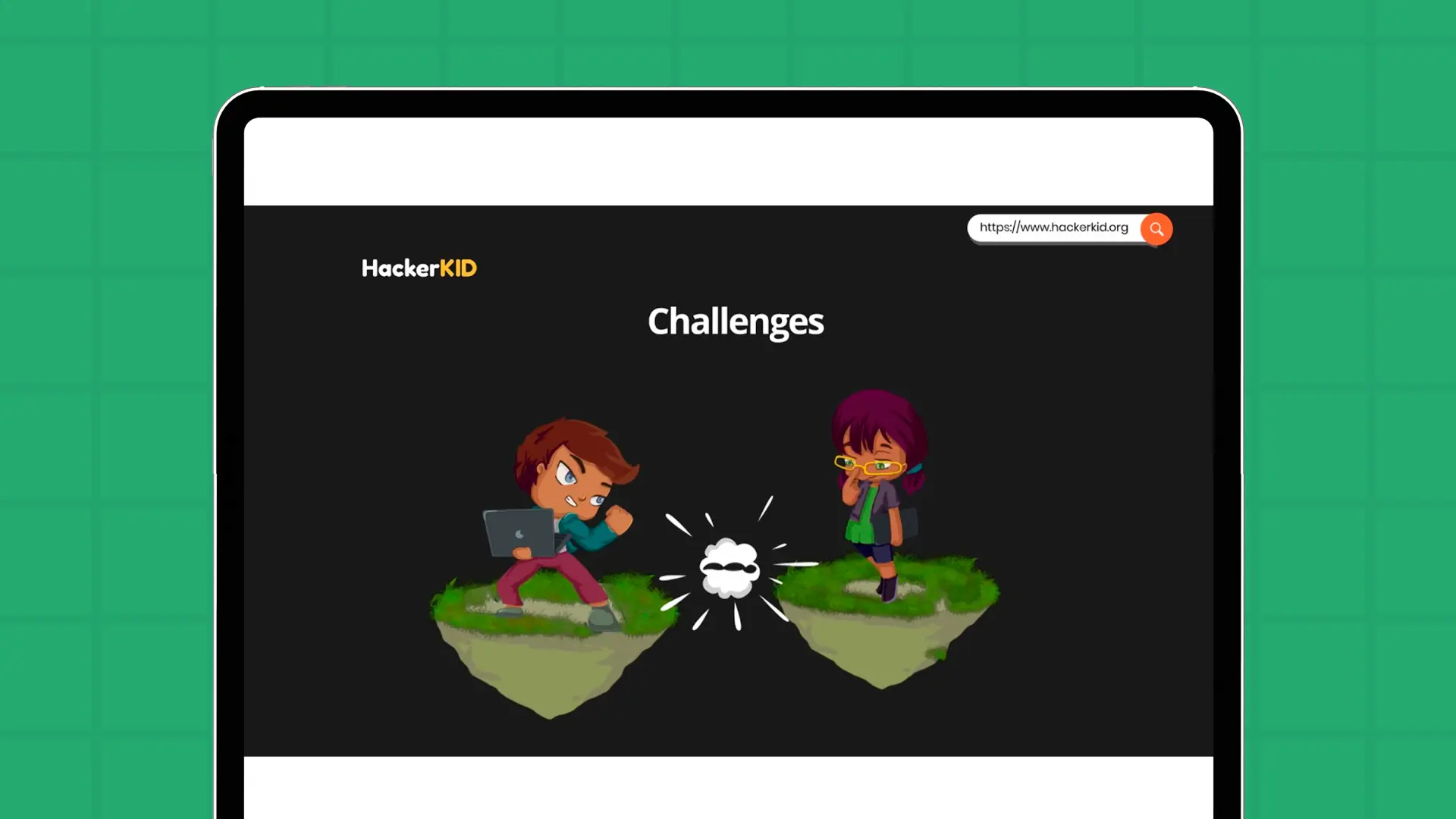
HackerKID’s ‘The Turtle Game’ introduces kids to the basics of Python in the most fun and interactive way. Kids learn about loops, functions, and how to bring their creative ideas to life through drawing and design by coding their turtle.
As they level up, they earn rewards and compete for leaderboards, getting a sense of achievement and motivation for further learning.
- Platform: Any platform with Python installed, such as Windows, macOS, or Linux.
- Age range: Ideal for kids aged 7 and up.
- Resources required: A computer with Python installed.
- Learning objectives: Understand basic Python syntax, loops, functions, and creative design.
- Estimated time: Varies, but most projects can be completed in a few hours.
- Coding concepts: Loops, functions, variables, and basic Python syntax.
- Interactive elements: Kids can customize their turtle’s appearance and the drawings it creates.
- Parental involvement: Minimal, but helpful for setup and initial guidance.
- Learning progression: Start with simple shapes and gradually introduce more complex designs.
- Link: hackerkid.org
2) Mad Libs
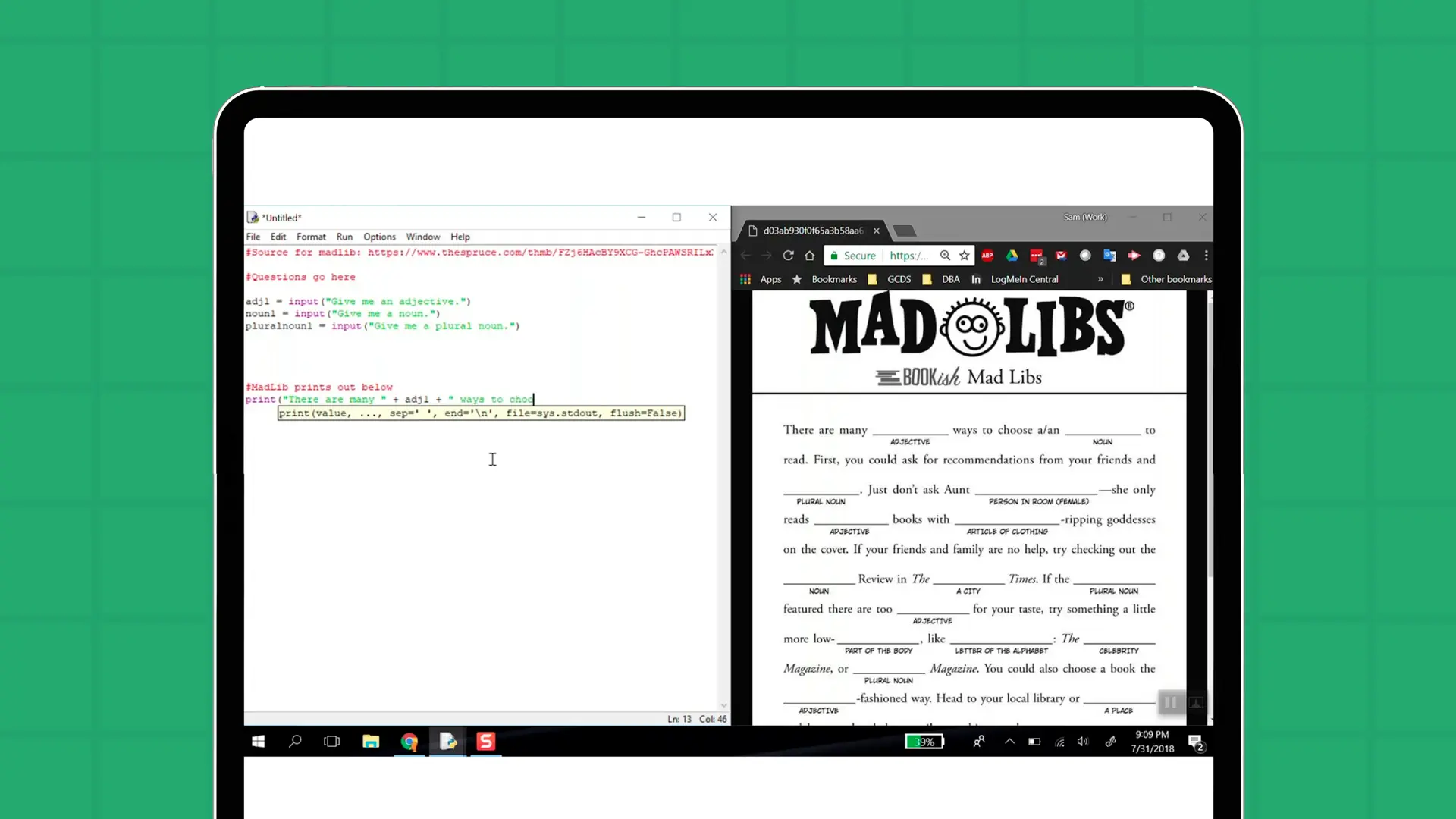
Next up is the Python-powered Mad Libs game! This project lets kids craft their own interactive stories by filling in the blanks with their choice of words.
Kids will see their unique and often humorous story come to life as they input various nouns, adjectives, verbs, and more. It’s a fantastic way for them to practice Python coding while exploring creative writing and storytelling.
- Platform: Any platform with Python installed, such as Windows, macOS, or Linux.
- Age range: Suitable for kids aged 8 and above.
- Resources required: A computer with Python installed.
- Learning objectives: Learn to handle user inputs, manipulate strings, and use concatenation for text manipulation.
- Estimated time: 1-2 hours to complete the project.
- Coding concepts: User input, string manipulation, variables, and concatenation.
- Interactive elements: Kids can create multiple versions of stories by changing the inputs.
- Parental involvement: Helpful for explaining string manipulation and concatenation concepts.
- Learning progression: Begin with simple stories and gradually introduce more complex sentence structures.
- Link: madlibs.com
3) Guess the Number
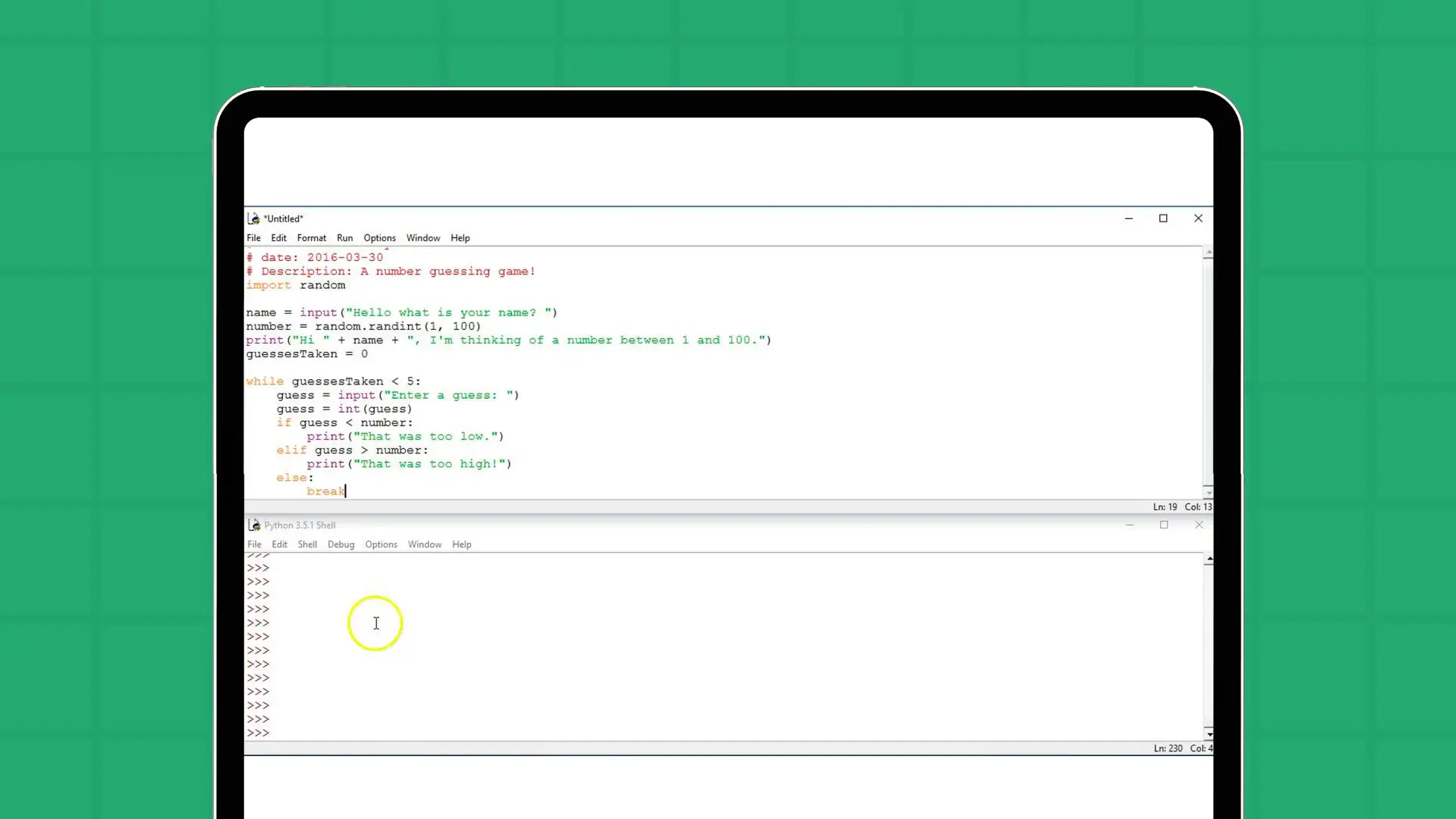
“Guess the Number” is an exciting Python kid project that invites them to code a game where they guess a number the computer has randomly chosen.
This project is perfect for young coders who love solving puzzles and want to learn to work with randomness and loops and make code interact with the user.
- Platform: Any platform with Python installed, such as Windows, macOS, or Linux.
- Age Range: Suitable for kids aged 8 and above.
- Resources Required: A computer with Python installed.
- Learning Objectives: Understanding random number generation, basic loop structures, and conditional statements.
- Estimated Time: About 1-2 hours, depending on the child’s familiarity with Python.
- Coding Concepts: Random numbers, loops (for/while), conditional logic (if/else), user input, and data type conversion.
- Interactive Elements: The game involves guessing numbers and receiving immediate feedback, making it highly interactive.
- Parental Involvement: Minimal, mainly to explain concepts or troubleshoot issues.
- Learning Progression: Start with simple guess ranges and gradually introduce more complex logic or larger ranges.
- Links: Various websites, such as codingnomads.com or geeksforgeeks.org, offer tutorials.
4) Quiz App
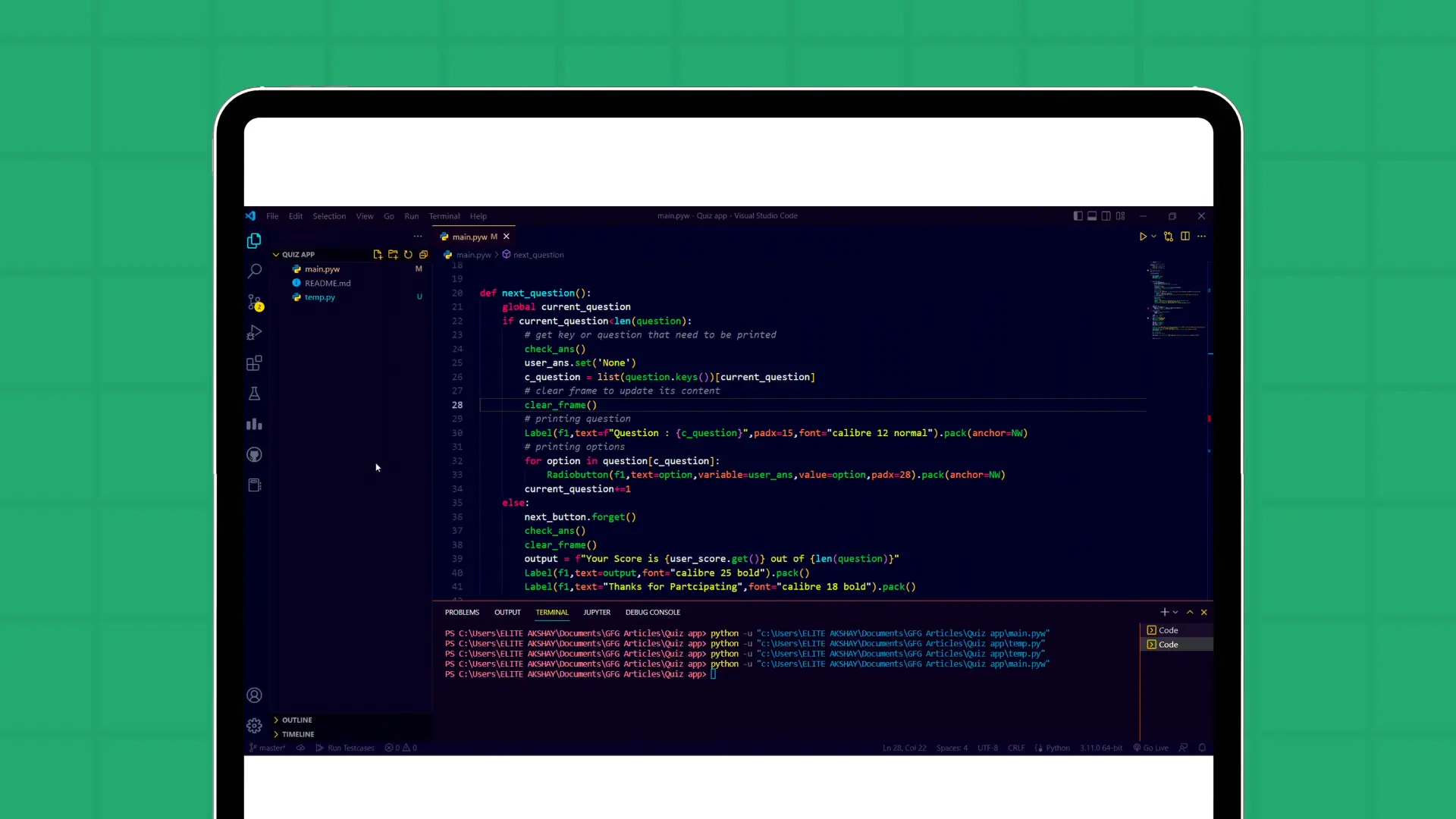
The “Quiz App” Python project lets kids create a quiz to test knowledge on various subjects. They’ll use important programming concepts like dictionaries for storing questions and answers, loops to go through each question, and conditional statements to check answers.
This engaging project boosts coding skills and knowledge in different areas, making learning both fun and rewarding.
- Platform: Any platform with Python installed, such as Windows, macOS, or Linux.
- Age range: Ideal for kids aged 10 and above.
- Resources required: A computer with Python and a text editor installed.
- Learning objectives: Learn to manipulate data structures like dictionaries, handle user inputs, and apply logical conditions to evaluate answers.
- Estimated time: Approximately 2-3 hours, depending on the complexity of the quiz.
- Coding concepts: Dictionaries, loops, conditionals, len() function, and incrementing values.
- Interactive elements: Interactive quiz format with immediate feedback on answers.
- Parental involvement: Can be involved in brainstorming quiz questions or helping to debug.
- Learning progression: Start with simple quizzes on familiar subjects and progress to more complex topics or coding challenges.
- Links: Various websites such as Scratch.mit.edu or Codecademy.com offer tutorials.
5) Strong Password Generator
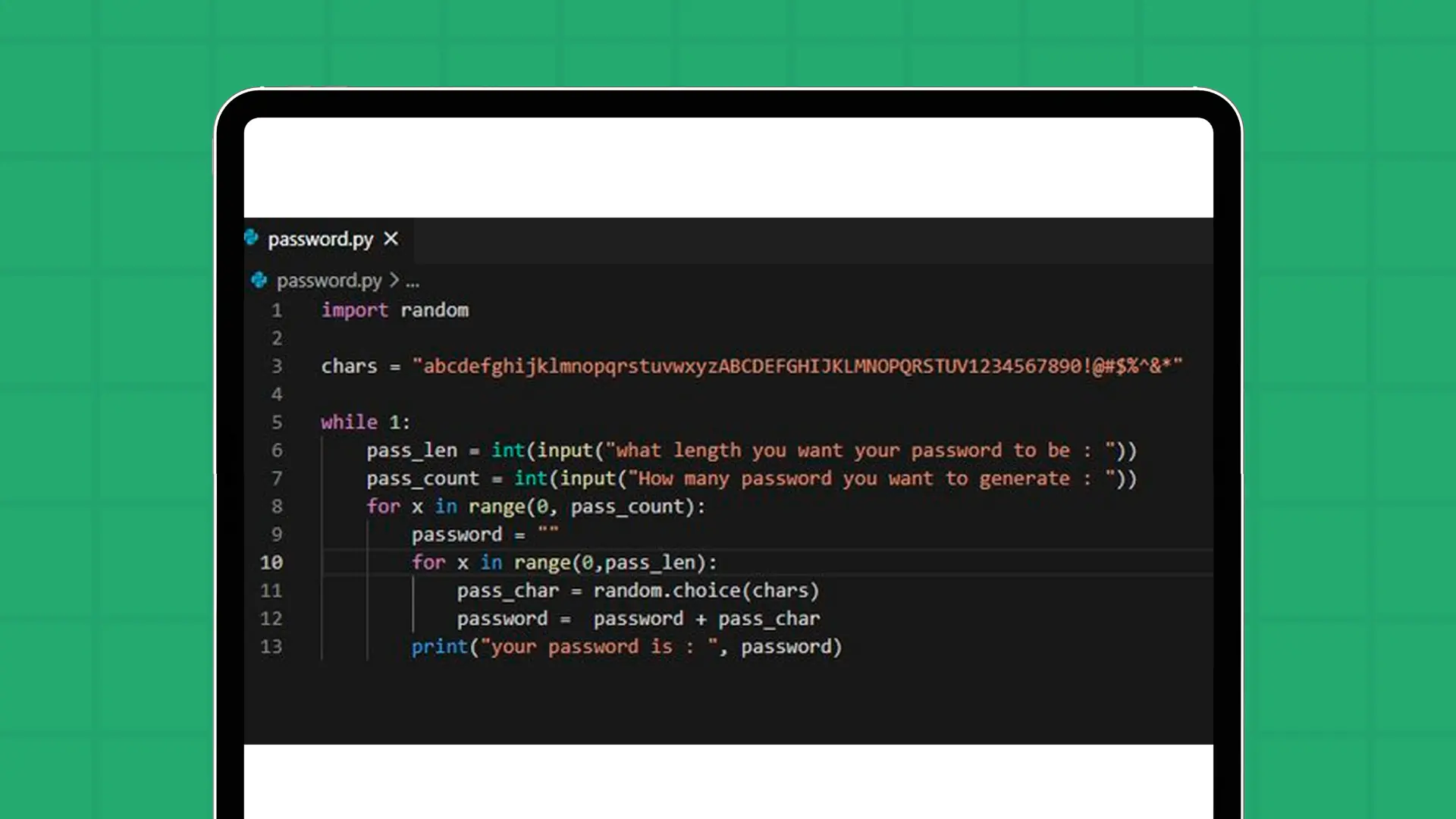
With the “Strong Password Generator” Python project, kids can get into the basics of cybersecurity by learning how to create robust passwords using Python.
This project uses Python’s string module for character selection, generates random integers for unpredictability, and applies loops and conditional statements to create a secure password. It’s a practical way to introduce kids to the importance of online security while enhancing their programming skills.
- Platform: Any platform with Python installed, such as Windows, macOS, or Linux.
- Age range: Suitable for kids aged 10 and above.
- Resources required: Python environment (like IDLE).
- Learning objectives: Understand cybersecurity basics, string manipulation, and random number generation.
- Estimated time: 1-2 hours to complete the project.
- Coding concepts: String manipulation, random number generation, loops, and conditional statements.
- Interactive elements: Kids can customize password criteria (length, character types).
- Parental involvement: Minimal, mainly to explain the concept of strong passwords.
- Learning progression: Start with simple passwords, then introduce complexity (symbols, numbers).
- Links: Various websites, such as Geekedu.org or Codingal.com, offer tutorials.
Also Read: Top 10 Fun Coding Projects for Kids
Learning tech has never been this fun!
Say goodbye to dull quizzes and hello to Buzzer, the ultimate computer science and technology MCQ game for kids! Pick your favorite topic, hit the buzzer, and tackle exciting gamified questions. Whether you’re playing for fun or competing, every round is an adventure. Think fast, answer smart, and climb the leaderboard. Play Buzzer now!
6) Random Name Generator
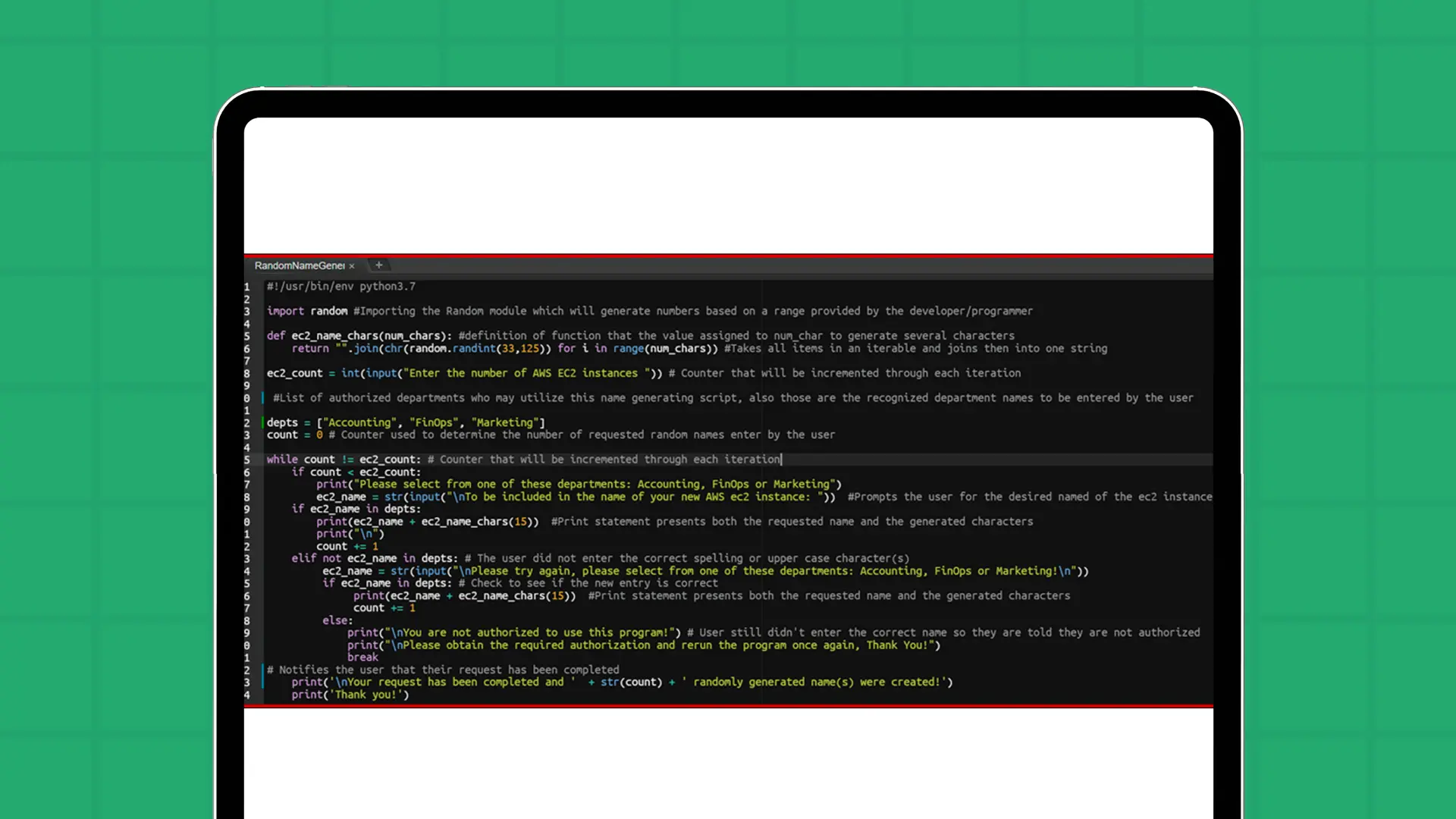
(insert single image #6)
The “Random Name Generator” Python project allows kids to combine coding with creativity to generate unique nicknames.
The program will intersperse a whimsical nickname in between by inputting first and last names, utilizing Python’s capabilities for string manipulation, list usage, and random selection.
- Platform: Any platform with Python installed, such as Windows, macOS, or Linux.
- Age range: Ideal for kids aged 8 and above.
- Resources required: A computer with Python installed.
- Learning objectives: Master string manipulation, list handling, and random element generation.
- Estimated time: About 1-2 hours to complete this engaging project.
- Coding concepts: Focus on variables, lists, modules, and f-strings for dynamic string creation.
- Interactive elements: Kids can input different names and receive a variety of fun nicknames.
- Parental involvement: Minimal, mainly to guide the initial setup and explain the concepts.
- Learning progression: Start with simple name combinations before introducing more complex nickname criteria.
- Links: Various websites, such as Skoolofcode.us or CodewizardsHQ.com, offer tutorials.
7) Video Game Browser
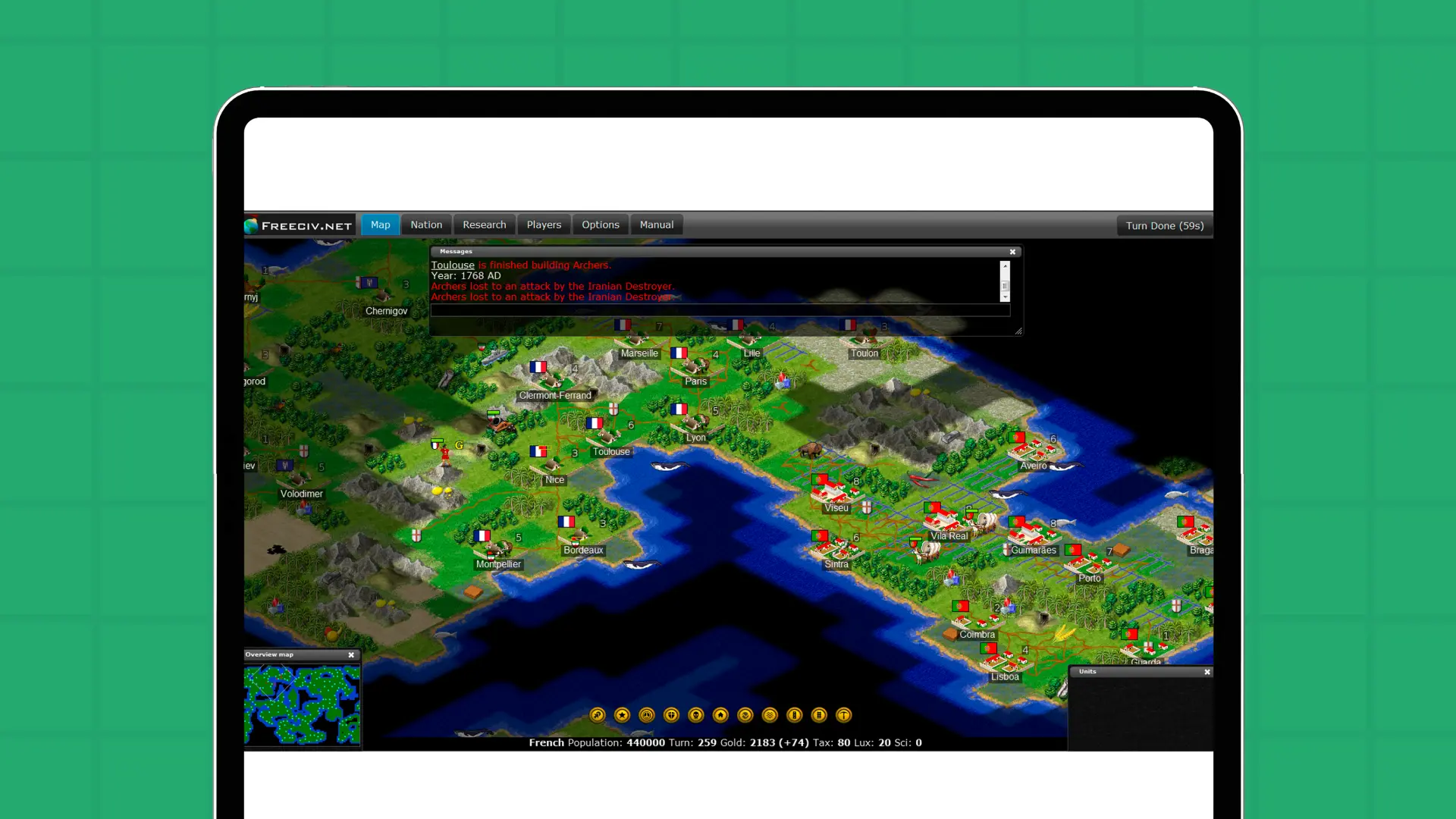
(insert single image #7)
The “Video Game Browser” Python project for kids is a fascinating way to get into data handling. They’ll learn to navigate through a vast database of video games, using keywords to fetch relevant information.
This project is perfect for kids to hone their data analysis skills and understand how to manage large datasets effectively.
- Platform: Any platform with Python installed, such as Windows, macOS, or Linux.
- Age range: Suitable for kids 10 years and older.
- Resources required: Python environment and access to a CSV file containing video game data.
- Learning objectives: To understand data handling, especially reading from CSV files and processing data based on user input.
- Estimated time: This project might take a few sessions, each lasting about 1-2 hours.
- Coding concepts: Focuses on file handling, loops, conditional logic, and string manipulation in Python.
- Interactive elements: Kids can interact with the program by inputting search terms and receiving tailored game information.
- Parental involvement: Guidance may be needed to explain CSV file handling and to assist with debugging.
- Learning progression: Start with basic data retrieval and advance to more complex data filtering and presentation.
- Links: Various websites, such as CodewizardsHQ.com or Opensource.com, offer tutorials.
Learning tech has never been this fun!
Say goodbye to dull quizzes and hello to Buzzer, the ultimate computer science and technology MCQ game for kids! Pick your favorite topic, hit the buzzer, and tackle exciting gamified questions. Whether you’re playing for fun or competing, every round is an adventure. Think fast, answer smart, and climb the leaderboard. Play Buzzer now!
Final Words
Python projects for kids are fun and a great way to master a valuable skill set. They can enhance their creativity, problem-solving abilities, and logical thinking by engaging in the listed projects.
Encourage your kids to try any of these Python projects and ignite a lifelong passion for technology and innovation within them. Happy coding!
Want to give your child a head start in coding? With HackerKid, they’ll follow a well-structured path built by experts, engage in fun, hands-on learning, and build real projects along the way. No confusion, no aimless browsing, just the right guidance at the right time.
Fill out the form for a personalized roadmap and start your child’s tech journey today!
Frequently asked questions
1. How can I select the right Python project for my child’s age?
To choose the right Python project for kids, consider their interests, attention span, and previous exposure to coding concepts. Start with simple projects and gradually increase complexity as they gain confidence.
2. Can a kid with no prior coding experience start with these Python projects?
Yes, these Python projects are designed to be accessible for kids with no prior coding experience, introducing basic concepts in a fun, engaging way.
3. What materials or software do I need for Python projects for kids?
For most Python projects, you’ll need a computer with Python installed. Some projects may require additional software or libraries, which are typically free and easily downloadable.
4. Can my child complete these projects independently, or is parental guidance required?
While some projects are designed to be straightforward for kids to tackle independently, others might benefit from parental guidance, especially for younger children or more complex tasks.
5. Is there a recommended order for completing the projects to ensure a logical learning progression?
It’s best to start with simpler projects focusing on basic concepts and gradually moving to more complex ones, ensuring a smooth learning curve.
6. Where can I find additional resources for my child to continue learning and exploring Python?
For additional resources, read more blogs on HackerKID. With interactive games, challenges, and projects, HackerKID makes exploring Python fun and accessible, encouraging continuous learning and discovery.







